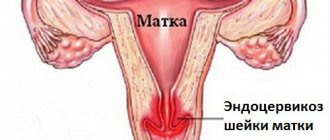Precancerous diseases of the cervix are pathological changes in the normal structure of the cervix, primarily affecting epithelial cells. In the structure of all gynecological diseases, uterine precancer accounts for 15%; women over 30 are at risk. The main dangerous manifestations include a long asymptomatic course and a high probability of transition to the next stage - oncological.
The positive aspects that reduce the percentage of precancer turning into cancer include the gradual formation and ease of diagnosis. A routine gynecological examination reveals most precancerous and background diseases. The gradual course consists in the sequence of development (gynecological disease - precancerous condition - cancer). It is precisely this mechanism for the development of pathological processes in the female body that makes it possible to prevent the precancerous condition of the uterus even at the stage of gynecological diseases. For example, eliminating an infection that provokes cell degeneration processes will stop the development of precancerous pathology.
This means that paying close attention to your health and regular visits to the gynecologist (scheduled and when any alarming symptoms appear) will help identify pathology at the earliest stages. At this point, the disease responds well to treatment, which helps prevent its further development. Let us consider in detail what precancerous and background pathologies of the uterus are, what they are, how they arise, develop and are treated.
Storm zone
The cervix is the part of the uterus visible during a gynecological examination that protrudes into the vagina. Its surface is covered with stratified squamous epithelium (MSE), which can resist infections, injuries and the pathologically aggressive environment of the vagina. This type of fabric has many layers, quickly regenerates, and has a light pink or grayish color.
The inner surface of the cervix (cervical canal) is covered with a completely different type of epithelium - cylindrical. It is more delicate, single-layer and is not suitable for testing on the vaginal part. The color of the fabrics is bright, red, allowing one to determine the transition zone (transformation) in the external pharynx.
The border between these tissues is the most vulnerable; gynecologists call it the “zone of storms” or the zone of transformation, since this is where most pathologies arise (both oncologically dangerous and background ones).
Conditionally dangerous are any changes in the integumentary tissues of the cervix. But background and precancerous diseases of the cervix are distinguished by the main feature - whether the morphology of the cell is affected.
Treatment methods
There are two approaches to treating precancerous conditions:
- medicinal;
- non-medicinal.
Drug therapy includes taking pharmaceuticals depending on the root cause of the pathology.
The non-drug approach is based on:
- laser exposure to the affected area;
- cryodestruction;
- surgical intervention.
Drug treatment
Conservative treatment tactics involve the use of certain pharmacological agents:
- for viral or bacterial infections, antiviral and antibacterial agents are prescribed (Isoprinosine, Panavir, Cycloferon);
- for fibroids, endometriosis, pseudo-erosion, which appeared against the background of hormonal imbalance, hormonal drugs are prescribed (for women of reproductive age, gynecologists recommend taking estrogens and gestagens; for women after menopause, estriol hormone is prescribed);
- to maintain, restore and stimulate immune defense, immunomodulators and immunostimulants (Licopid, Immunomax, Isoprinosine) will be relevant in treatment;
- In addition to the main treatment, B vitamins and antioxidant complexes (Lycopene, Dibikor, Glutargin) are prescribed;
- taking local dosage forms to restore vaginal microflora (Fluconazole, Pimafucin, Nystatin).
Conservative tactics are effective only if the patient is diagnosed with a mild degree of the underlying disease. In the presence of even the first stage of dysplasia, such treatment can only block the further development of the pathology and prepare the female body for surgical treatment.
In addition, surgery may be prescribed if drug treatment is ineffective. The surgical approach can vary in scope; sometimes local exposure is sufficient while preserving the integrity of the reproductive organ. But in more severe situations, complete or partial resection of the uterus is performed.
Surgery
Background pathologies, as a rule, are effectively eliminated using conservative techniques, but in some situations this approach cannot be used as an independent approach. For example, in the presence of polyps (especially adenomatous ones), surgical intervention is required.
The decision on radical methods of therapy is made by the doctor after studying the research results, analyzing the clinical picture and the degree of threat to the woman’s life. Surgical treatment is based on various techniques and approaches.
To eliminate the source of damage, the following methods can be used:
- local destruction (radio waves, cryodestruction, laser, diathermosurgery);
- radical surgery (hysterectomy, excision, reconstructive plastic surgery, removal).
After the operation, the patient is prescribed a therapeutic course of treatment, including the use of drugs to normalize and stimulate the impaired functions of the reproductive organ.
This:
- treatment of the postoperative area with topical antibacterial and antiseptic solutions;
- taking immunomodulators, vitamin complexes and hormones;
- the use of traditional medicine to restore the lost functions of the genitourinary system.
After the operation, all patients are monitored in gynecology for 2 years. This is associated with a high risk of relapse. In addition, doctors strongly recommend paying special attention to prevention.
A healthy lifestyle, preventing infection and sexually transmitted diseases, changing the method of contraception, etc., contributes to the speedy restoration of the functions of the genitourinary system and the prevention of the development of pathology again.
Background processes
Background diseases are considered to be any deviations from the normal state of the mucous membrane, when the cells retain their properties and structure, but can be found “out of place” or damaged.
Background diseases of the cervix develop in the presence of such unfavorable factors:
- Early onset of sexual activity: immature epithelium is easily damaged.
- Late first birth or childlessness. Constant ovulation leads to depletion of the reproductive and protective forces of the body.
- Frequent change of sexual partners: the danger of sexually transmitted infections and exposure to foreign microflora, to which immunity does not have time to develop.
- Traumatic childbirth, ruptures with subsequent scarring, abortion or curettage.
- Inflammation or dysbiosis in the vagina.
Hormonal changes during adolescence, menopause, and endocrine disorders in women of any age can also lead to various diseases and pathological conditions.
All genital bacterial infections, as well as viruses, can cause diseases of the cervix, affecting its tissues, and some provoke malignant degeneration.
Erosion (true)
Any unfavorable conditions in the vagina can cause disruption of the integrity of the epithelium covering the cervix. Inflamed areas, ulcerations occur, and some tissue areas die. This condition is called true erosion.
When the traumatic factor is eliminated, inflammation subsides, destroyed tissues quickly regenerate, becoming covered with healthy, young layers of squamous epithelium. Typically, true erosion heals quickly - epithelization occurs on its own within a few weeks.
Pseudo-erosion (ectopia)
If the eroded surface is covered with columnar epithelium instead of flat epithelium, pseudoerosion is diagnosed. The zone of transition from one type of tissue to another shifts, and upon examination reveals itself as spots and marble stains of red color. Since the endometrium has fewer protective properties than squamous epithelium, if it appears “out of place,” it is more easily affected by infections, injured, and bleeds. Ectopia is often congenital and does not require treatment.
A variant of ectopia is ectropion (eversion) of the mucous membrane from the cervix into the vagina when the genital area is immature in girls and girls, as well as after childbirth in adulthood. Eroded ectropion is the same inversion, but as a result of ruptures of the cervix or uterine body. In this case, pseudo-erosion is accompanied by the appearance of scars.
Leukoplakia
At different stages of pseudo-erosion, abnormal keratinization of tissues may be observed. The affected areas rise above the level of normal epithelium in the form of white plaques that cannot be removed as plaque.
Simple leukoplakia does not affect the deep layers, does not lead to cell changes and is a background disease of the cervix. The atypical form is characterized by increased cell division with changes in their structure and is a precancerous condition.
Erythroplakia
A rare form of squamous epithelium pathology, when it becomes so thin that blood vessels are visible through it. As a result, the lesion appears as a bumpy red spot against a background of paler, healthy tissue.
Polyps
Such endometrial growths most often appear inside the cervical canal. Their appearance is associated with hormonal, immune, and metabolic disorders in the body. These round-shaped formations on thin stalks can appear singly or in groups. Only the adenomatous appearance of polyps is a harbinger of oncological abnormalities.
Papillomas
Growths of a viral nature are found on the cervix in the form of clearly defined rosettes, consisting of elongated threads or papillae. As the cause of pathological proliferation of the epithelium, the herpes virus and human papillomavirus (HPV) are most often identified. Several types of papillomas have a tendency to malignant degeneration; the most aggressive of the viruses are HPV strains 16 and 18.
Endometriosis
A common pathology when the intrauterine endometrium grows beyond normal limits, covers neighboring organs, is found in the peritoneum, or “grows” into the muscular walls of the uterus. The process is provoked by injuries to the mucosa during examinations, operations, and ruptures. During menstruation, the endometrium, implanted in inappropriate places, begins to bleed under the influence of hormones, as a result of which the surrounding tissues become inflamed.
All of these diseases do not turn into cancer on their own. For the development of precancerous processes, in addition to the “soil” in the form of background diseases of the cervix, provoking factors and additional conditions are necessary.
Classification of diseases
In gynecology, there are several types of female diseases that can later become malignant. At the same time, timely detection of these pathologies can successfully prevent such an outcome. Therefore, a woman needs to be attentive to her health and regularly visit a gynecologist. Medical examinations and tests make it possible to identify precancerous diseases of the uterine cervix (as well as background ones) at a time when they are still benign and respond well to treatment with both therapeutic and surgical methods.
Background diseases of the uterus are the initial stage, at which structural changes in cells have not yet occurred. But the influence of risk factors (most often, HPV) already leads to tissue changes and pathological processes begin.
Precancerous diseases are more dangerous; they are characterized by degeneration of the epithelium already at a deep cellular level, when the structure changes and an abnormality of its development begins. This is a rather thin line that separates partially modified cells from oncology. Any of their conditionally pathogenic factors can provoke their final degeneration into atypical ones.
Women at any age should know which diseases of the reproductive system are background and precancerous conditions. Knowing the typical symptoms will help them contact a specialist in a timely manner. Therefore, it is worth learning more about each pathology that can develop into cancer.
Background
Background diseases of the cervix are a fairly large group that combines all diseases recognized as benign, but over time capable of degenerating into a malignant form.
Background processes of the cervix include:
- Erosion of any type (false and true). It is no coincidence that this disease is divided into 2 types: real and false. One form quickly transforms into another. The surface defect of the stratified squamous epithelium is degraded and rejected (true erosion), and then replaced by a cylindrical one (false).
- Endometriosis: penetration of endometrial cells into the submucosal space with subsequent development and formation of localized lesions of different color, shape and size.
- Eversion (ectropion): occurs as a result of injury, looks like a false erosion. Over time, the cervix becomes deformed, hypertrophies, undergoes cystic transformation and scars.
- Pappillomatosis: is defined as local hyperplasia in the stratified epithelium followed by focal organization.
- Polyposis: abnormal growth of the mucous membrane leads to the formation of polyps of various types, single or multiple.
- Cirvitis: inflammatory disease of the cervical canal or vaginal part of an infectious etiology.
- Lacerations, fistulas and scars. Rupture is a violation of integrity, mainly during difficult childbirth. Fistulas are pathological anastomoses that violate the integrity of an organ and connect it to others. Scars - the damaged area is able to regenerate on its own, and the epithelium is replaced with connective tissue.
Often the underlying disease is asymptomatic and is detected only during examination. Therefore, patients who ignore regular visits to the gynecologist are at particular risk.
Precancerous pathologies
The precancerous condition of the cervix is more dangerous; at any moment it can enter the stage of degeneration and lead to oncology. This group also includes several pathologies that are not related to each other in etiology, but have the same signs of endometrial degeneration at the cellular level. These include:
- Erythroplakia: thinning of the epithelium, which is accompanied by damage to the mucosa and its atrophy in the future.
- Leukoplakia: characterized by keratinization of the epithelium.
- Cervical dysplasia (precancerous stage of pathology, very dangerous and the most common among precancerous conditions). It is characterized by structural changes in the epithelium with the appearance of atypical cells. Read more in the article: what is cervical dysplasia;
- Adenomatosis: this pathological condition can be divided into 2 types: a tumor (a polyp that is formed as a result of excessive growth of the endometrium) and precancerous uterine hyperplasia - a specific type of endometriosis. In both cases, there is a proliferation of endometrial glands and their atypical changes.
Any precancer must be treated immediately; the doctor chooses the tactics in accordance with its type and volume of the pathological focus. There is a generally accepted classification, according to which there are 3 stages of development of precancerous conditions according to the degree of severity: mild, moderate and severe. But there is no longer a 4th degree, the next condition is an oncological disease affecting the cervix.
How does a precancerous condition occur?
They change the structure of the cell from the inside, which means they provoke its degeneration, some aggressive infections. Their pathogens are able to penetrate a cell and introduce their DNA into the nucleus.
The main infectious agents of precancer, according to statistics, are:
- human papillomavirus (HPV), found in 95% of patients with cervical cancer;
- herpes virus type 2, in recent years herpes type 1 has often been diagnosed;
- intracellular bacterial infections such as chlamydia trachomatis.
Additionally, the presence of several infections or their combination with HIV increases the likelihood of developing precancer.
A favorable environment for the development of pathology is created by the following factors:
- smoking;
- reduced immunity;
- early sexual activity, frequent change of partners;
- uncontrolled use of hormonal contraceptives;
- cervical injuries associated with childbirth or abortion, use of intrauterine contraception;
- unbalanced diet, lack of vitamins;
- age-related changes in the reproductive organs;
- genetic predisposition.
Most often, several negative factors are present at once, which worsens the prognosis and complicates the treatment of the pathology. Successful therapy requires lifestyle changes, otherwise the treatment will not work and relapses and re-infections are possible.
Papillomatosis
Papillomas are benign tumors formed from altered epithelium due to HPV infection. The virus is transmitted through sexual contact, during medical interventions with non-sterile instruments, and also from mother to baby during childbirth.
The affected area in this pathology is not classified as leukoplakia, although the tips of the tumors are white, so they look like a white spot on the uterus. HPV does not immediately begin to attack, but only when the immune defense weakens.
Papillomas may have sharp ends or may be flat. In the case of recent neoplasms, when the vaginal biocenosis is disrupted and the immune system is suppressed, malignant degeneration is possible.
As papillomas develop, they sometimes form a growth, which is a white spot on the cervix.
Papillomatosis has a number of symptoms:
- unpleasant odor of vaginal discharge;
- pain during sexual intercourse;
- itching and burning of the vaginal area;
- bloody contact discharge;
- discomfort in the lower abdomen.
If you notice these symptoms, contact your gynecologist.
If during the examination he sees white spots on the uterus, then further examination will allow him to differentiate leukoplakia and papillomatosis. When the diagnosis is in favor of HPV, treatment is selected based on the following factors:
- woman's age;
- type of HPV;
- results of cytological examination;
- appearance of papillomas;
- state of the immune system.
If necessary, tumors are removed. To suppress HPV, special drugs with antiviral activity are used. Additionally, the patient is prescribed a multivitamin complex. Getting rid of HPV is very difficult, sometimes even impossible, but taking the virus under control is possible.
Dysplasia - cervical precancer
The term dysplasia covers all types of precancerous conditions of the cervix. In the literature and when making a diagnosis, the correct scientific name is cervical intraepithelial neoplasia (CIN).
Dysplasia is said to occur when disturbances occur in the cervical epithelium already inside the cell. The size and shape of the nucleus changes, sometimes there are several nuclei, and extra vacuoles appear. Typically, cells tend to divide rapidly, but do not spread beyond the mucous membrane.
Dysplasia develops starting from the deep layers of the epithelium, moving to the superficial layers. The topmost layer is not affected and all changes occur secretly, in the middle layers of tissue.
Classification:
- CIN-I - mild degree of dysplasia: no more than a third of the thickness of the mucosa is affected, starting from the basal layer (base tissue);
- CIN-II - a condition of moderate severity with changes in tissue structure and atypical processes in the cells of half the thickness of the mucosa;
- CIN-III is a severe degree of dysplasia with damage to more than 2/3 of tissues, significant cell abnormalities, and their rapid division.
- Dysplasia does not have a fourth stage; beyond this border oncology begins.
Cytological signs of dysplasia:
- acanthosis;
- hyperkeratosis;
- parakeratosis;
- increased cell division activity;
- dyskaryosis: polymorphism and vacuolization of nuclei;
- cell proliferation;
- foci of atypia.
Medicine classifies the first two stages as reversible processes. Timely, adequate treatment can stop the pathological process. Due to the growth of normal cells, abnormal ones are “pushed” to the surface and rejected. The third stage is a dangerous condition that leads to the development of cervical cancer and requires surgical treatment.
Pathologies related to precancerous diseases
Experts identify several main groups of diseases that contribute to the development of genital cancer in women. A common feature of all groups is difficulty in diagnosis and differentiation, as well as a practically asymptomatic course.
Main types of pathologies:
- Viral . They pose a particular danger to the patient. This includes HPV, especially strains 16, 18 and 31, as well as some viral sexually transmitted diseases. They lead to the formation of growths on the epithelium and stimulate cervical dysplasia. A separate risk group includes patients with HIV. Decreased immunity against the background of this pathology sharply increases the chance of developing cancer cells.
- Inflammatory processes and traumatic injuries. Inflammations that begin against the background of traumatic sexual intercourse or unsuccessful surgical interventions in the pelvic area often lead to weakened immunity, which contributes to the development of HPV and other viruses dangerous to the cervix. Inflammation can independently lead to dysplasia (the main type of precancerous condition of the uterus).
- Bacterial infections. For example, chlamydia, although it rarely causes cancer when it occurs on its own, increases the likelihood of developing it if it is coinfected with HPV.
The list of diseases that contribute to the development of cancer includes many other names:
- herpes;
- endometriosis;
- leukoplakia;
- cytomegalovirus infection;
- ectropion;
- adenomatosis;
- erythroplakia.
Diagnostics
As a rule, background and precancerous (benign) diseases of the cervix disappear without specific symptoms. This is the insidiousness of such diseases - without regular examinations by a gynecologist, it is impossible to determine that the pathological process has begun. Symptoms in the form of discharge and pain manifest themselves as concomitant infections or advanced stages.
- During a gynecological examination, the prerequisites for further examinations are clarified. For early detection of pathologies, extended colposcopy, cytological examinations of smears, and tests for infections are performed.
- Colposcopy allows the doctor to more accurately examine general, visible changes in the cervix. Staining tests highlight areas of pathological condition of the epithelium. Colpomicroscopy can be comparable in accuracy to histological examination, but does not violate the integrity of tissues.
- Cytological studies of smears from different parts of the uterus provide an incomplete picture, their accuracy barely reaches 50%, therefore, to clarify the diagnosis, a histological examination is prescribed, taking samples using a biopsy method.
- Using the Schiller test (Lugol staining), areas for biopsy are identified. Pathological tissues are not stained; material is taken from such places for analysis. A biopsy gives a reliable result in diagnosing dysplasia and determining its stage. The procedure is also required in case of persistent erosion.
- Testing for HPV, herpes simplex virus, chlymydia and other infections.
- Tests and research are not all that is required for effective treatment. At an appointment with a gynecologist, you should discuss as openly as possible all the risk factors and negative aspects that influence the development of the disease. Without a general assessment of a woman’s quality of life and social behavior, it is impossible to recommend adequate therapy and reduce the risks of malignant tumors.
During colposcopy, the doctor identifies pathological areas that are not stained with Lugol's solution (an iodine-based drug). These lesions are called acetowhite epithelium. During the procedure, other changes are revealed:
- punctuation;
- mosaic (rough and delicate);
- vascular network.
All these phenomena indicate the presence of pathology and require additional examination.
Of great importance in the diagnosis of precancerous conditions and cervical cancer is the detection of signs of HPV infection. Typical manifestations of HPV infection in gynecology are presented in the table.
| State | a brief description of |
| Koilocytosis | The appearance of large dark cells with a light zone around the nucleus. Cells are binucleate or multinucleate |
| Dyskeratosis | Pathological keratinization in stratified squamous epithelial cells. Cells with a small nucleus and bright pink cytoplasm appear. Cells accumulate keratin |
| Parakeratosis | The appearance of a layer of keratinized cells |
| Hyperkeratosis (leukoplakia) | Formation of a separate stratum corneum |
Symptoms
Analyzing the signs that characterize one or another precancerous condition of the cervix, one can notice that for some conditions the symptoms are almost the same. Therefore, doctors pay great attention to differential diagnosis and the results of histological studies. However, the general condition of patients may differ, so we will consider the symptoms inherent in each type of pathology separately.
Background diseases
Background processes of the cervix are often asymptomatic in the early stages. But each of them has characteristic symptoms, which, if they appear, serve as a signal for an extraordinary visit to the gynecologist.
- Erosion. Often does not cause symptoms at all; it is detected and differentiated during a gynecological examination. Pain during sexual intercourse and spotting after it are the main symptoms. If there is a change in the menstrual cycle and heavy discharge without odor or color, then the disease progresses quickly.
- Endometriosis. The main symptom will be pain in the lower abdomen (causeless, before, during and after menstruation, during sexual intercourse, and less often during bowel movements). The cycle is disrupted, before and after menstruation bloody discharge (spotting) appears and uterine bleeding begins, infertility develops.
- Eversion (ectropion). Characterized by pain in the lower abdomen, lower back and contact, itching and discharge of a light milky color and bloody, changes in the cycle.
- Pappillomatosis: symptoms in the form of discharge appear only when an infection is attached.
- Polyposis: polyps of various types are characterized by manifestations in the form of pain, cycle disorders, infertility, discharge, but most often the course is asymptomatic.
- Cirvitis: aching pain, including during urination and contact pain (during sexual intercourse), cloudy discharge - these are the main symptoms of this disease, characteristic of all its forms.
- Lacerations, fistulas and scars. The main symptom of a rupture is bleeding. The main symptom of fistulas is the appearance of uncharacteristic discharge, for example, urine when connected to the bladder. Scars as such cannot be considered a disease, but connective tissue atypical for the cervix can be injured. Then the corresponding symptoms appear - pain and bleeding.
Precancerous
Precancerous diseases of the uterus also often have common symptoms. For accurate diagnosis, various instrumental and laboratory methods are used, histological examination is of particular importance.
- Erythroplakia: usually asymptomatic, sometimes spotting and leucorrhoea appear.
- Leukoplakia: symptoms appear exclusively as a complication in the form of an infectious disease, most often pain, various discharges, and cycle disruption.
- Dysplasia: the course is completely similar to the picture with leukoplakia;
- Adenomatosis: with polyps of the adenomatous type, symptoms are practically absent and appear against the background of infectious diseases. With adenomatosis, standard signs for gynecological diseases are noted: pain, discharge, menstrual irregularities, etc.
Asymptomatic progression is a common sign of background and precancerous conditions of the cervix, which is why they are dangerous. Most often, the appearance of any unpleasant sensations and other signs is explained by the cause of their occurrence - an infection that develops and progresses over time. And then it involves more and more cells in the pathological process and becomes the cause of their degeneration.
Treatment
Having established an accurate diagnosis and found out the causes of its occurrence, the gynecologist determines a treatment strategy. In the case of underlying diseases and the initial stages of precancer, conservative treatment with constant monitoring of results is indicated.
Possible areas of therapy for cervical diseases:
- cure sexually transmitted infections;
- hormonal correction;
- antiviral therapy;
- measures to strengthen immunity;
- changing the method of contraception;
- to give up smoking.
In any case, vitamin complexes will be prescribed to maintain the normal functioning of all body systems and increase resistance to infections.
The frequency of observations is determined by the attending physician, but a prerequisite is colposcopy and cytology at least once every 3 months. Observation is carried out for about 2 years; if the situation worsens, methods for surgical removal of pathological tissues may be proposed. Most often, strict adherence to recommendations over time allows you to get rid of an unpleasant diagnosis.
For the surgical treatment of background and precancerous diseases of the cervix, many modern methods of hardware removal have been developed. For excision, radio wave and laser knives, cauterization and freezing removal are used. Along with modern ones, conventional surgical removal is used during classical surgery. In each case, the method of getting rid of unwanted tissue is selected according to indications, availability and possible risks for the patient.
To remove tissues with precancerous changes and cancer in the early stages, there are special techniques for conization, partial and complete removal of the cervix. In advanced cases, as well as for postmenopausal patients, complete removal of the uterus and appendages is used. Every woman can prevent a situation where doctors have to fight not just for the health, but for the life of the patient.
Dysplasia is the most common pathology of all possible diseases of the cervix, and only about 10% of severe dysplasia progress to the stage of oncology. Therefore, when you hear a frightening diagnosis - a precancerous condition of the cervix, you should not panic, but act. Modern medicine, coupled with the efforts of the woman herself, can defeat this dangerous enemy.
Cervicitis
If you have been diagnosed with cervicitis and during an examination white spots are found on the uterus, the doctor will explain what it is. This pathology means that the cervical canal has become inflamed due to a sexually transmitted infection.
Symptoms of cervicitis are:
- pain in the lower abdomen is predominantly nagging or dull;
- vaginal discharge with an unpleasant odor;
- pain during sex;
- painful urination.
A spot on the cervix will indicate that the area of infection has not healed properly. It is very important to start therapy on time using antibiotics and other drugs prescribed by your doctor. It is important that both partners are treated at once.
Prevention
Prevention of cervical cancer includes:
- Refusal of casual sex.
- Maintaining intimate hygiene.
- Timely implementation of reproductive function.
- Regular examinations with a gynecologist.
- Mandatory examination when planning pregnancy.
- Timely treatment of identified background and precancerous pathologies of the cervix.
An effective method of preventing cancer is HPV vaccination. Before getting vaccinated, it would be a good idea to consult your doctor.
Read
Also:
- What is cervical erosion
- Prevention of osteoporosis: how to prevent osteoporosis in women
- How does a cervical biopsy occur during erosion: preparation, course of the operation, rehabilitation period
- Analysis for oncocytology of the cervix - what is it?
Diagnostic methods
Since the symptoms of cervical precancer are very similar, much attention is paid to differential diagnosis. In addition to visual inspection, various methods are used, namely:
- collecting smears for a Pap test;
- colposcopy (simple, advanced, with drug tests, etc.);
- cervicoscopy;
- curettage and biopsy;
- cytological studies;
- urine (general) and blood analysis (general, biochemistry, RW, HIV, HbsAg);
- Ultrasound.
A mandatory method will be a histological examination of scrapings and biopsies; in addition, a number of samples and tests are performed to make the diagnosis extremely accurately. The list of mandatory diagnostic measures includes tests that allow you to determine the infection that caused the occurrence of pathological processes.
General information
Precancerous diseases of the cervix are dysplastic processes in the vaginal part of the cervix with a high risk of malignancy. In gynecology, a distinction is made between background diseases of the cervix (pseudo-erosion and true erosion, polyps, simple leukoplakia, endometriosis, ectropion, papillomas, cervicitis) and precancerous ones. Background pathologies are characterized by normoplasia of epithelial cells - their correct division, maturation, differentiation, and rejection.
A distinctive feature of precancerous diseases of the cervix is that they occur with epithelial dysplasia - its hyperplastic transformation, proliferation, impaired differentiation, maturation and exfoliation. However, unlike cervical cancer, all of these cellular changes are limited to the basement membrane. In most cases, precancerous processes develop in the area of underlying diseases and are often masked by them, which makes timely diagnosis difficult. The average age of patients with cervical precancer is 30-35 years.
Precancerous diseases of the cervix
4. Treatment of diseases
Treatment of cervical diseases depends on their causes, dynamics, the presence of concomitant diseases, other factors and risks. Conservative treatment is preferable. Based on the diagnostic results, it can be aimed at treating underlying somatic and gynecological diseases, which may include hormone therapy, antiviral and antibacterial drugs, immunomodulatory or physiotherapeutic treatment.
If therapy does not bring a positive result, surgical treatment is used. Surgery for benign cervical diseases includes:
- diathermocoagulation (excision with an electric knife and cauterization);
- radio wave treatment (more gentle, suitable for nulliparous women, since it does not leave scars on the cervix);
- laser (excision and cauterization with a carbon dioxide laser);
- cryodestruction (freezing of endometrial layers using liquid nitrogen).
Recovery after surgical treatments sometimes lasts up to three months. In some cases, sexual activity is excluded during this period. It is very important to understand the danger of untreated benign diseases, since the constantly occurring processes of destruction and restoration of eroded tissues significantly increase the likelihood of malignant cells appearing in the cervix.
Symptoms
When a patient is diagnosed with a precancerous condition of the cervix, symptoms will vary depending on which disease is progressing. An important feature of the development of this type of pathology is that for a long time the signs may be insignificant or completely absent.
It often happens that the precancerous stage of the cervix is detected during a routine gynecological examination. However, it is worth saying that all the diseases that were presented in the classification have certain characteristics that need to be studied in more detail.
Erosion
Almost every woman has heard of or herself encountered such a pathology as erosion. If it is not recognized in a timely manner and treated, then with a high degree of probability it will cause uterine precancer to develop.
Erosion is a lesion that is localized on the surface layer of the vaginal mucosa. This appears due to the fact that a process occurs such as degeneration of flat epithelial cells, replaced by cylindrical ones. If we talk about the true type of the disease, it affects the external opening of the cervical canal.
Cervix with erosion and normal. Source: kleopatraclean.ru
During a gynecological examination, the doctor, using mirrors, will be able to identify the pathological area by its bright red color. In addition, the patient has contact bleeding. As this pathology progresses, the woman herself will feel some discomfort during intimacy, and the presence of beige or brown discharge cannot be ruled out.
True erosion occurs over a short period of time (only a few weeks). Subsequently, it will be filled with cylindrical cells that penetrate there from the cervical canal or are formed from reserve cells.
In this condition, they already talk about the progression of pseudo-erosion (ectopia or endocervicitis). However, you should not immediately think that cervical precancer is developing. What this is, the doctor will clarify during additional diagnostic procedures.
Polyps
When polyps form on the mucous membrane of the reproductive organ, a local proliferation of flat or prismatic cells is noted. Each of these neoplasms has a glandular component and a stalk formed from connective tissue.
If the polyps are simple, then they do not show signs of proliferation. But with the adenomatous form, the indicated activity will be present. As for the symptoms, there are practically no symptoms as this disease progresses. Sometimes patients complain of discomfort during intimacy, and if the polyp is traumatized, sanguineous exudate is released from the vagina.
In order to understand why cervical atypia began, what it is, and how dangerous it is, it is necessary to undergo a gynecological examination. During it, the specialist will be able to identify formations that have a round shape, pink color, and they are held in place by the stem. The surface of polyps is smooth or papillary, which depends on what type of epithelial cells they are covered with.
The consistency may also vary. Therefore, in some patients the formations are soft, while in others they are dense. This is due to the fact that the concentration of connective tissue in the structure of polyps can be different. If the proliferation process is active, then the growth of neoplasms will be rapid.
Papilloma
In most cases, papilloma develops on the cervix without any characteristic symptoms. However, if an inflammatory process begins to progress in the body, the volume of vaginal discharge may increase. But in most cases, the disease can only be diagnosed during a gynecological examination.
When cervical atypia develops with papilloma, what kind of process this is needs to be understood. With this type of disease, doctors talk about local hyperplasia of stratified squamous epithelium. At the same time, in the affected area there are areas with keratinized tissue. Their edge is clearly defined, the color is pale pink or whitish, the structure is papillary. The danger is that the level of malignant transformation is high.
Endometriosis
This type of pathology is characterized by the proliferation of endometrial cells beyond the reproductive organ. If there is any damage to the cervix, it is possible that endometrial cells during menstrual bleeding will penetrate into the submucosal layer, where they will continue to develop.
If such a condition occurs, then pathological foci of red, blue or brown color will be noticeable on the outer part of the cervix, and their sizes and shapes may vary. Such neoplasms rise above the surface of the cervix, and during menstruation their growth continues.
Growth of the endometrium outside the uterus. Source: colady.ru
It often happens that endometriosis occurs in combination with adenomyosis. With this tandem, the severity of symptoms will be more pronounced. The woman will begin to express the following complaints:
- Pain in the lower abdomen;
- Menstrual irregularities;
- Increase in the size of the uterus;
- Inability to conceive a child.
As endometriosis progresses, it is possible that cervical precancer will develop in the future. The symptoms that should be given the greatest importance are pain and menstrual dysfunction, expressed in algodysmenorrhea.
If a woman’s general health deteriorates, then dizziness and pain, nausea, vomiting, and possibly flatulence appear. Discharge during regulation can be either abundant or scanty, and there is a reduction or increase in its duration. Since this disease causes hormonal imbalances and adhesions form in the abdominal cavity, the risk of developing infertility is very high.
Dysplasia
When a precancerous condition of the uterus is identified, every woman should know what it is, because it is the most dangerous and common form of this condition. As the pathology progresses, a significant change in the structure of the epithelial layer is noted.
During gynecological and histological diagnostics, thickening of the mucous membrane is noted, as well as the presence of atypical cells in it. As for the characteristic symptoms, they are absent. But if the patient also has underlying diseases, their symptoms will be more pronounced.
Erythroplakia
When considering precancerous diseases in gynecology, we need to remember about such a condition as erythroplakia. If you know how this term is translated, you can understand that the formation looks like a bright red spot. However, it does not appear because there are inflammatory processes or areas with erosion in the body.
Healthy and atypical cells. Source: aptekins.ru
The main cause of erythroplakia is the thinning of the surface and intermediate layer of the epithelium. In this condition, doctors say that atrophy occurs. But with all this, detailed diagnostics show that the deep layers are thickening. This leads to the appearance of keratinization and atypical cells.
Leukoplakia
If such a precancerous condition of the cervix is detected, not all women know what it is and how it manifests itself. A characteristic feature of leukoplakia is a focal lesion of the stratified epithelium, in which keratinization of cells occurs. The neoplasm has an oval or spherical shape, it has clear edges, and the color is yellowish or whitish.
Upon closer examination of the affected area, you will notice that its surface is covered with scales, and the polygonal shape is achieved due to the fact that it is divided by small vessels. Since there is hyperplasia of the basal layer, the plaques are quite dense and rise above the surrounding tissues.
As in most cases, there are no characteristic symptoms. However, it is possible to notice indirect signs if you pay close attention to your condition. They will be expressed in the form of a large amount of leucorrhoea, discomfort during intimacy, and a feeling of dryness and itching will appear in the area of the external genitalia.
Ectropion
Ectropion means a kind of inversion of the mucous membrane lining the surface of the cervical canal. Symptoms of eversion are observed in the vaginal part of women. This pathological process can cause diseases and pathological conditions of the cervix, for example, cervicitis or erosion.
Gynecologists identify the following as causes of ectropion:
- embryonic disorders of the formation of epithelial tissue of the cervix;
- hormonal imbalance in girls;
- abortions and other surgical interventions;
- damage to the integrity of the cervix due to childbirth.
Signs of ectropion include:
- contact discharge accompanying intimacy and examination by a doctor;
- discomfort in the vagina;
- leucorrhoea;
- pain during sexual intercourse.
Treatment for cervical ectropion includes:
- cryodestruction;
- conization;
- conservative therapy with anti-inflammatory and hormonal agents.
The symptoms of ectropion are similar to other diseases of the reproductive system. To determine the pathology, differential diagnosis should be performed.








